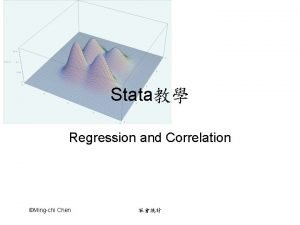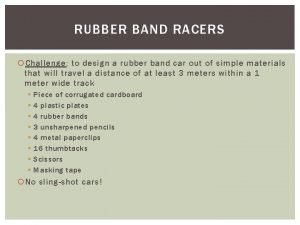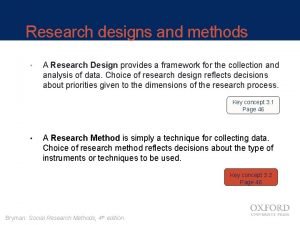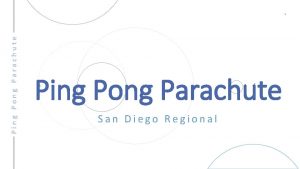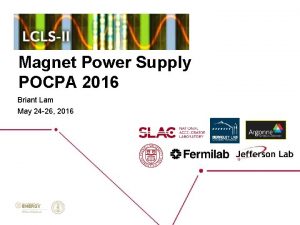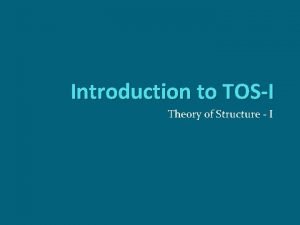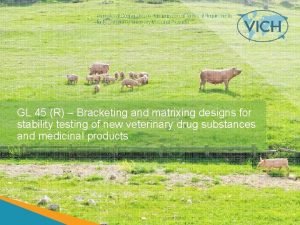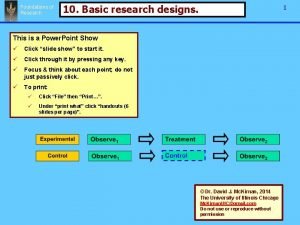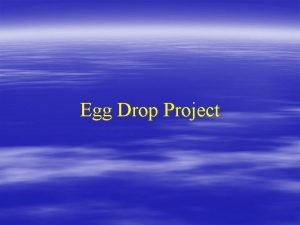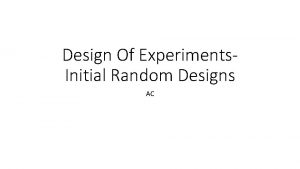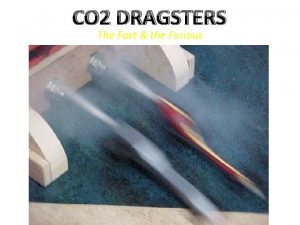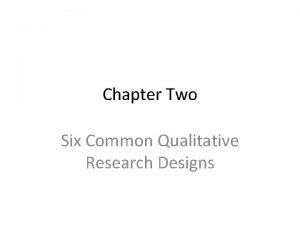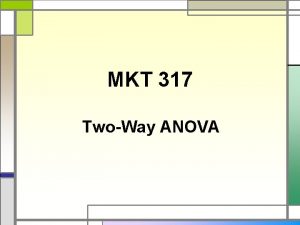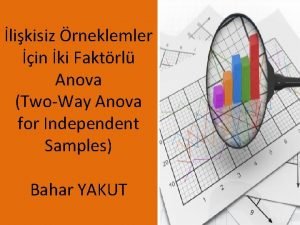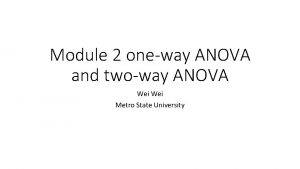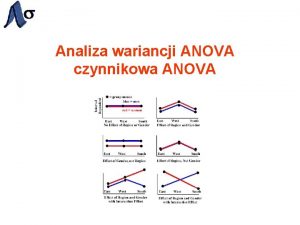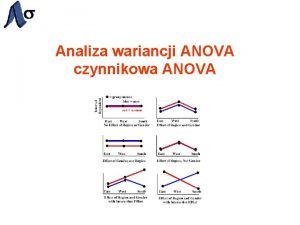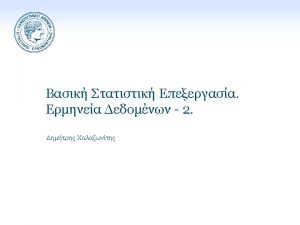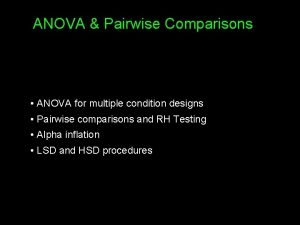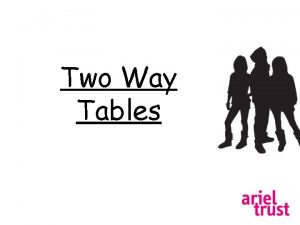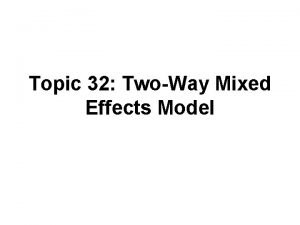Other ANOVA designs Twoway ANOVA Chapter 11 Twoway



































- Slides: 35

Other ANOVA designs Two-way ANOVA Chapter 11

Two-way ANOVA • In this chapter – Randomized block design – Factorial design


The randomized block design • Error variance를 분리해내기를 원하는 특성에 따라 실험개체들을 grouping (blocked) 한다 • Ex. 야생 쥐의 경우 litters (한배의 새끼)에 따라 grouping 한다 – Same litter의 경우 유전적으로 유사하고 same age 이므로 • 따라서 이 실험의 경우 실험대상 쥐들은 두 기준 (criteria)에 의해 분류됨 – Diet and litter – 각 diet and litter combination에 하나의 실험 개체가 존재 (no replication) – Two-way ANOVA without replication이라 부른다 – Mixed effects model • Diet: fixed factor; Litter: random factor


The randomized block design Variance (분산): -1. Total variance -2. Black (little)에 의한 분산 -3. Treatments (diets)에 의한 분산 -4. Error variance (오차분산)

The randomized block design • • Calculation steps 1. 각 행 (row)의 값을 합함 (Σxr) 2. 각 열 (column)의 값을 합함 (Σxc) 3. column total 이나 row total을 계산, 두 값이 동일 함 (Σxt) • 4. 각 행의 합을 제곱 {(Σxr)2}; 제곱한 값을 다 합한 후 treatments (columns)의 수로 나눔 Σ(Σxr)2 / c – In this case: Σ(Σxr)2 / c = (1197. 16 + 1296. 0 + …+ 1232. 01)/3 = 3553. 27 • 5. 각 열의 합을 제곱: {(Σxc)2}; 제곱한 값을 다 합한 후 rows (blocks)의 수로 나눔: Σ(Σxc)2 / r – In this case: Σ(Σxc)2 / r = (11384. 89 + 16358. 41 + 8226. 49)/10 = 3596. 98

The randomized block design • Calculation steps • 6. 모든 observations을 제곱한 후 합함: Σx 2 t – (11. 8)2 + (12)2 + …. . + (10. 1)2 = 3631. 47 • 7. grand total을 제곱한 후 total observations으로 나 눔: (Σxt)2 / nt – (325. 30)2 / 30 = 3527. 336 – Correction term

The randomized block design • Total sum of square (SSt: 6 – 7) – Σx 2 t - (Σxt)2 / nt – 3631. 47 – 3527. 336 = 104. 134 • Sum of square for treatments (columns) (SSc: 5 – 7) – Σ(Σxc)2 / r - (Σxt)2 / nt – 3596. 98 – 3527. 336 = 69. 643 • Sum of square for blocks (rows) (SSr: 4 – 7) – Σ(Σxr)2 / c - (Σxt)2 / nt – 3553. 27 – 3527. 336 = 25. 934 • Error sum of square – SSe = SSt - SSc - SSr – 104. 134 – 69. 643 – 25. 934 = 8. 557

The randomized block design • Total degree of freedom (dft: nt – 1) – 30 - 1 = 29 • Treatments (columns) 자유도 (dfc: columns – 1) – 3– 1=2 • Blocks (rows) 자유도 (dfr: rows – 1) – 10 – 1 = 9 • Error degree of freedom (dfe = dft - dfc - dfr) – 29 – 2 – 9 = 18

The randomized block design • ANOVA table • For diet treatments – – – Critical F value in table A. 6 (α=0. 05, df = 2, 18) F (df = 2, 15) = 3. 68 Calculated F (73. 25)가 critical F value보다 훨씬 크다 따라서 null hypothesis를 reject 결론: diets 가 체중증가에 유의하게 영향을 미친다

The randomized block design • For blocks – – – Critical F value in table A. 6 (α=0. 05, df = 9, 18) F (df = 9, 15) = 2. 59 Calculated F (6. 06)가 critical F value보다 훨씬 크다 따라서 second null hypothesis를 reject 결론: litters에 따라 차이가 있음 • litters에 의한 error variance가 randomized block design을 사용함으로써 분리되어짐 • Randomized block ANOVA로는 treatments와 blocks 사이의 interaction (교호작용)을 알 수 없다 – Interaction: treatments가 blocks 에 따라 따르게 영향을 미 칠 경우, 또는 combined effects of the treatments and blocks 이 개개의 treatments와 blocks effects의 합과 다를 경우 – Two-way factorial design으로 interaction 을 알 수 있다


The randomized block design • 각행의 합 – 220, 208, 175, 187, 218 – 합의 제곱의 합 Location Diet A Diet B Diet C 1 65 75 80 2 60 69 79 3 55 50 70 4 53 54 80 5 64 69 85 • 48400+43264+30625+34969+47524 = 204782 • 각열의 합 – 297, 317, 394 – 합의 제곱의 합 • 88209+100489+155236 = 343934 • Correction term – (Σxt)2 / nt = 1016064/15 = 67737. 6 • Σx 2 t – 69484

The randomized block design Location Diet A Diet B Diet C • Total sum of square (SSt) – Σx 2 t - (Σxt)2 / nt – 69484 – 67737. 6 = 1746. 4 • Sum of square for treatments (columns) (SSc) – Σ(Σxc)2 / r - (Σxt)2 / nt – 17641. 8+20097. 8+31047. 2 – 67737. 6 = 1049. 2 • Sum of square for blocks (rows) (SSr) – Σ(Σxr)2 / c - (Σxt)2 / nt – 68260. 67 – 67737. 6 = 523. 07 • Error sum of square – SSe = SSt - SSc - SSr – 1746. 4 – 1049. 2 – 523. 07 = 174. 13 sum 1 65 75 80 220 2 60 69 79 208 3 55 50 70 175 4 53 54 80 187 5 64 69 85 218 297 317 394

The randomized block design • Total degree of freedom (dft: nt – 1) – 15 - 1 = 14 • Treatments (columns) 자유도 (dfc: columns – 1) – 3– 1=2 • Blocks (rows) 자유도 (dfr: rows – 1) – 5– 1=4 • Error degree of freedom (dfe = dft - dfc - dfr) – 14 – 2 – 4 = 8

The randomized block design • ANOVA table Source SS df MS F Diets 1049. 2 2 524. 6 24. 1 Blocks (location) 523. 07 4 130. 77 6. 01 Error 174. 13 8 21. 77 Total 1746. 4 14 • For diet treatments – – – Critical F value in table A. 6 (α=0. 05, df = 2, 8) F (df = 2, 8) = 4. 46 Calculated F (24. 1)가 critical F value보다 훨씬 크다 따라서 null hypothesis를 reject 결론: diets 가 두꺼비의 혈압에 유의하게 영향을 미친다

The randomized block design • ANOVA table Source SS df MS F Diets 1049. 2 2 524. 6 24. 1 Blocks (location) 523. 07 4 130. 77 6. 01 Error 174. 13 8 21. 77 Total 1746. 4 14 • For locations – – – Critical F value in table A. 6 (α=0. 05, df = 4, 8) F (df = 4, 8) = 3. 84 Calculated F (6. 01)가 critical F value보다 크다 따라서 null hypothesis를 reject 결론: location에 따라 차이가 있다


The Friedman test • Measurement scale? ? – Ordinal scale – 따라서 nonparametric test를 사용해야 함 – 각 개체들은 연속적으로 test 되었으므로 observations들은 independent 하지 않음: related sample


The Friedman test • k columns (8) and n rows (6) • ΣRi: sum of rank of a column • = 12/6× 8× 9 {(45. 5)2 + (35. 5)2 + (23)2 + (26. 5)2 + (27)2 + (23. 5)2 + (19)2 + (16)2} – (3× 6× 9) = 17. 44 • Degree of freedom: k – 1 = 8 – 1 = 7 • Critical chi-square value from Table A. 3: 14. 07 • Calculated chi-square value가 critical value보다 크다 • 자극시간에 따른 차이가 없다는 귀무가설을 reject • 결론: 뱀은 연속적인 자극에 약화되는 반응을 보인다

The factorial design • 많은 경우 두 factors (treatments)가 서로 상호작용 하여 각각의 factors의 합과 다른 effects를 줄 수 있 다 • In other word, treatments 들은 synergistically or antagonistically 영향을 미칠 수 있다 • Ex. 여러 종류의 약을 동시에 먹을 경우 유해한 영향 이 나타날 수 있다 • Treatments 사이에 interaction이 예견될 경우 factorial design을 사용

The factorial design • Both factors가 treatments로 고려됨 – Both treatments가 fixed effects 임 • Treatments 사이에 interaction이 있음 • 각 treatments의 combinations 은 replicated observations을 가짐 • Two-way ANOVA with replication이라 불림

The factorial design • Ex. 11. 2: a factorial design ANOVA – Diets 와 stress가 생쥐의 체중증가에 미치는 영향을 알고 자함 – Interaction effects도 알고자 함 – 32마리의 inbred mice를 실험동물로 사용 – Random 하게 4 groups으로 나눔 (8마리 씩) – Treatments • Diet: 2 treatments: junk food and control food • Stress: 2 treatments: High stress and low stress – Group 1: junk food + low stress – Group 2: junk food + high stress – Group 3: control food + low stress – Group 4: control food + high stress

The factorial design • Ex. 11. 2: a factorial design ANOVA – High stress: 매일 8시간 rap music – Low stress: 매일 8시간 classical music • Null hypothesis – 1. Effect of stress • H 0: Low = High vs Ha: Low ≠ High – 2. Effect of diet • H 0: Control = Junk food vs Ha: Control ≠ Junk food – 3. Interaction effect • H 0: no interaction vs Ha: interaction

The factorial design Variance (분산): -1. Total variance -2. Diet에 의한 분산 -3. Stress에 의한 분산 -4. Interaction에 의한 분산 -5. Error variance (오차분산)

The factorial design • Preliminary calculations as shown in Table 7. 11

The factorial design • Total sum of square (SSt) – Σx 2 t - (Σxt)2 / nt – 591136 – (4332)2/32 = 4691. 5 • Sum of square for stress (SSs) – (Σx. L)2 / n. L + (Σx. H)2 / n. H - (Σxt)2 / nt – (2058)2/16 + (2274)2/16 - (4332)2/32 = 1458 • Sum of square for diet (SSd) – (Σx. J)2 / n. J + (Σx. R)2 / n. R - (Σxt)2 / nt – (2278)2/16 + (2054)2/16 - (4332)2/32 = 1568

The factorial design • Sum of square for interaction (SSi) – (Σx. HR)2 / n. HR + (Σx. LR)2 / n. LR + (Σx. HJ)2 / n. HJ + (Σx. LJ)2 / n. LJ - (Σxt)2 / nt – SSs – SSd – (1060)2/8 + (998)2/8 + (1218)2/8 + (1056)2/8 - (4332)2/32 – 1458 – 1568 = 312. 5 • Error sum of square – SSe = SSt - (SSs + SSd + SSi) – 4561 – (1458 + 1568 + 312. 5) = 1222. 5

The factorial design • Degree of freedom for each main effect – Groups – 1 = 2 – 1 = 1 • Degree of freedom for interaction – dfstress * dfdiet = 1 * 1 = 1 • Total degree of freedom – nt – 1 = 32 – 1 = 31 • Error degree of freedom – dfe = dft - dfs - dfd - dfi = 31 – 1 – 1 = 28

The factorial design • • • Fstress = 1458 / 48. 32 = 30. 18 (df = 1, 28) Fdiet = 1568 / 48. 32 = 32. 46 (df = 1, 28) Finter = 312. 5 / 48. 32 = 6. 47 (df = 1, 28) Critical F value in Table A. 6 (α=0. 05, df = 1, 25): 4. 24 Calculated F value가 critical F value보다 크다 – 따라서 귀무가설을 reject • Stress 와 diet가 체중증가에 영향을 미치며 두 factors 사이에 interaction이 있다


Homework • 45마리의 guppy 암컷을 9 groups으로 random하 게 나눔 • 물의 온도 3가지 (70ºF, 75ºF, 80ºF), 3 가지 feeding 횟수 (1, 2, 3회)로 two-way factorial design • Offspring (새끼)의 수가 수온이나 feeding 횟수에 영향을 받는가? 이 두 factors의 interaction이 있 는가? • Both by hand using computer software

Homework Temperature 70°F 75°F 80°F Number of daily feedings 1 2 3 18 25 28 20 30 36 15 19 29 27 30 30 30 25 37 20 28 33 28 29 39 30 32 42 17 38 47 29 29 38 35 35 51 30 39 42 32 30 48 28 40 39 35 38 55
 Draw a correlation
Draw a correlation Perbedaan two way anova dan one way anova
Perbedaan two way anova dan one way anova One way anova vs two way anova
One way anova vs two way anova Contoh one way anova dan two way anova
Contoh one way anova dan two way anova Self initiated other repair
Self initiated other repair Findings of qualitative research
Findings of qualitative research Chapter 10 qualitative research designs
Chapter 10 qualitative research designs Characteristic of
Characteristic of Water rocket simulator
Water rocket simulator Used to transfer marks from the pattern to the fabrics
Used to transfer marks from the pattern to the fabrics Ancient egyptian floral design
Ancient egyptian floral design Rubber band racer designs
Rubber band racer designs Cross sectional research design
Cross sectional research design Turf areas in xeriscaping designs should be seeded in
Turf areas in xeriscaping designs should be seeded in Principles of experimental design
Principles of experimental design Premier jewelry home shows
Premier jewelry home shows Ping pong parachute
Ping pong parachute Example of output design
Example of output design Abstraction-occurrence design pattern
Abstraction-occurrence design pattern Medieval shield designs
Medieval shield designs Caylua designs
Caylua designs Triangular arch
Triangular arch Pure romance party invitation wording
Pure romance party invitation wording Hopewell designs
Hopewell designs French baroque floral design
French baroque floral design Matrixing and bracketing
Matrixing and bracketing Basic research designs
Basic research designs Factorial designs
Factorial designs Matched pairs design
Matched pairs design Straw egg drop design
Straw egg drop design Channel design decisions steps
Channel design decisions steps Random designs
Random designs Computer arithmetic: algorithms and hardware designs
Computer arithmetic: algorithms and hardware designs Fast dragster designs
Fast dragster designs Fast dragster designs
Fast dragster designs Types of qualitative design in research
Types of qualitative design in research
